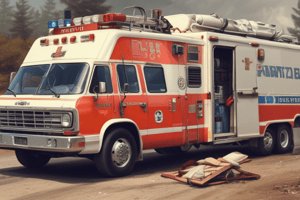Podcast
Questions and Answers
In a situation with multiple casualties, which individuals should be helped first?
In a situation with multiple casualties, which individuals should be helped first?
- Those who are conscious
- Those who are more than three people
- Those with life-threatening conditions (correct)
- Those with minor injuries
What is the primary survey designed to assess?
What is the primary survey designed to assess?
Life-threatening conditions
The primary survey includes checking for airway, breathing, and circulation.
The primary survey includes checking for airway, breathing, and circulation.
True (A)
To open the airway, place one hand on the forehead and tilt the head back while using two fingers to lift the ____.
To open the airway, place one hand on the forehead and tilt the head back while using two fingers to lift the ____.
What should you remove from the mouth and nose to clear the airways?
What should you remove from the mouth and nose to clear the airways?
A casualty can breathe if there are visible obstructions in their airway.
A casualty can breathe if there are visible obstructions in their airway.
What is the correct way to check for breathing?
What is the correct way to check for breathing?
If a casualty is not breathing, what immediate action should be taken?
If a casualty is not breathing, what immediate action should be taken?
It is safe to put yourself at risk while assisting a casualty.
It is safe to put yourself at risk while assisting a casualty.
Study Notes
Assess the Casualty and Give First Aid Treatment
- Prioritize helping casualties with life-threatening conditions first if there is more than one.
- Use the primary survey to manage life-threatening situations.
- After dealing with life-threatening conditions, move to the secondary survey.
The Basics
- Bleeding: Assess, control, and treat bleeding.
- Puncture Wounds: Use the primary survey to address any life-threatening conditions.
- Bleeding Emergencies: Treat according to the severity of the bleeding.
- Fracture: Use the primary survey to address any life-threatening conditions.
- Burns: Treat according to the severity of the burn.
- Choking: Use the primary survey to address any life-threatening conditions.
- Sprains: Treat according to the severity of the sprain.
- Syncope: Use the primary survey to address any life-threatening conditions.
- Heat Related Illnesses: Treat according to the severity of the illness.
Objectives
- Learn the principles of first aid.
- Identify emergency situations where basic first aid can be applied.
- Understand anatomical and physiological causes of emergencies and appropriate first aid responses.
Role of the First Aider
- First aid is the immediate help provided to injured or ill individuals.
- The role of a first aider is to provide safe and effective assistance without putting themselves at risk.
What to Do?
- Assess the situation quickly and calmly.
- Prioritize safety:
- Check for danger to yourself and the casualty.
- Protect yourselves from further harm.
- Move the casualty only if it minimizes harm.
- Call for emergency help if the area is unsafe.
- Assess the scene:
- Determine the cause of the incident and the number of casualties.
- Assess the situation:
- Identify the specific nature of the emergency.
Primary Survey
- The primary survey is a rapid assessment used to identify and treat life-threatening conditions in a prioritized order.
- Airway:
- Ensure the airway is open and clear by:
- Tilting the head back and lifting the chin.
- Removing visible obstructions like vomit, mucus, teeth, or food.
- An obstructed airway prevents breathing and impedes rescue breathing or mouth-to-mouth resuscitation.
- Ensure the airway is open and clear by:
- Breathing:
- Check for breathing by:
- Observing chest rise and fall.
- Listening for breathing sounds.
- Feeling for exhaled breath.
- Assess for regular or irregular breathing patterns.
- If the casualty is not breathing:
- Initiate rescue breathing or mouth-to-mouth resuscitation (EAR).
- If the casualty is breathing:
- Continuously monitor breathing.
- Apply rescue breathing if breathing stops.
- Note the respiration rate for communication to medical professionals.
Studying That Suits You
Use AI to generate personalized quizzes and flashcards to suit your learning preferences.
Related Documents
Description
This quiz covers essential first aid techniques for various medical emergencies. Learn how to prioritize care for life-threatening conditions and understand the appropriate treatments for bleeding, burns, fractures, and more. Test your knowledge on how to effectively assess and manage different injuries and illnesses.




